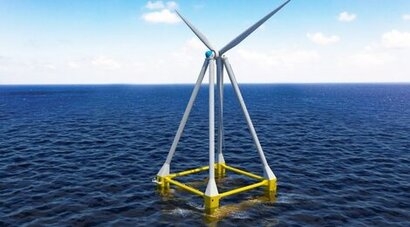
The EU-backed project is one of three to be awarded by the European Commission’s Horizon Europe research and innovation programme last year, all aimed at sustainable energy solutions, with a grant agreement signed at the end of 2022. BLOW will use Eolink’s wholly unique floating offshore wind turbine design, and aims to engineer, manufacture and commission the 5 MW unit by 2025 before rolling out large-scale deployment as part of a wider industrialisation process. Eolink’s patented concept addresses ongoing industry issues by spreading the turbine’s stresses using four steel masts instead of one, offering a competitive weight-to-energy ratio that makes the overall structure more than 30 percent lighter.
“The objective of this specific project is to demonstrate the competitiveness of floating offshore wind in lower-wind areas with the deployment of a large rotor diameter” said Eolink’s CEO and Founder, former Renault engineer Marc Guyot. “Winning this award has allowed us to take one step further towards our ultimate goal: offering a viable energy source that is as low-carbon as possible.”
The sixteen European partners include Spanish-based IREC and Acciona, the Turkish Offshore Wind Energy Association, German research organisation the Fraunhofer Institute, and the European Marine Energy Centre in Scotland. The unit will be connected to an existing gas platform operated by Petroceltic, a Bulgarian oil and gas company. GSP offshore, a Romanian offshore services operating company, will manufacture the unit in their shipyard in Constanta (Romania).
“The World Bank 2021 report indicates there is vast technical potential in South East Europe, with a staggering 166 GW of floating offshore energy in the Black Sea alone, which is the equivalent of five times the electricity consumption of Bulgaria and Romania” added Eolink's Chief Commercial Officer, Alain Morry. “Through this project we hope to catalyse offshore development across the region, which already has ongoing fixed-bottom offshore wind projects in Romania.”
The meeting last week laid out a development plan that will see an initial phase of engineering, environmental and social impact assessment before entering the construction phase. The unit will be designed to operate with maximum efficiency in the Black Sea, including adapting it with a larger rotor so it can generate more energy in low-wind areas.
The project marks Eolink’s second deployment of its patented concept in Europe after the France Atlantic Project, which aims to be connected to the French government grid by 2024.
For additional information:

